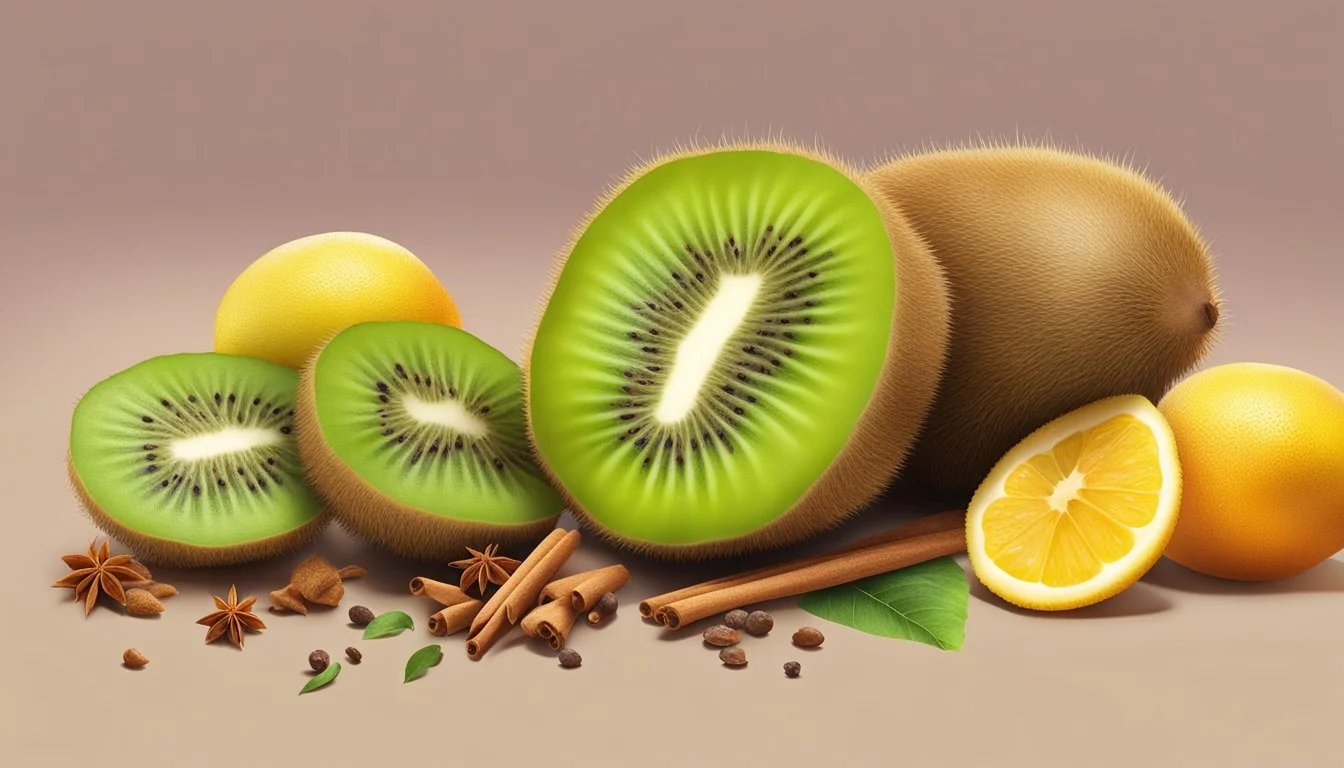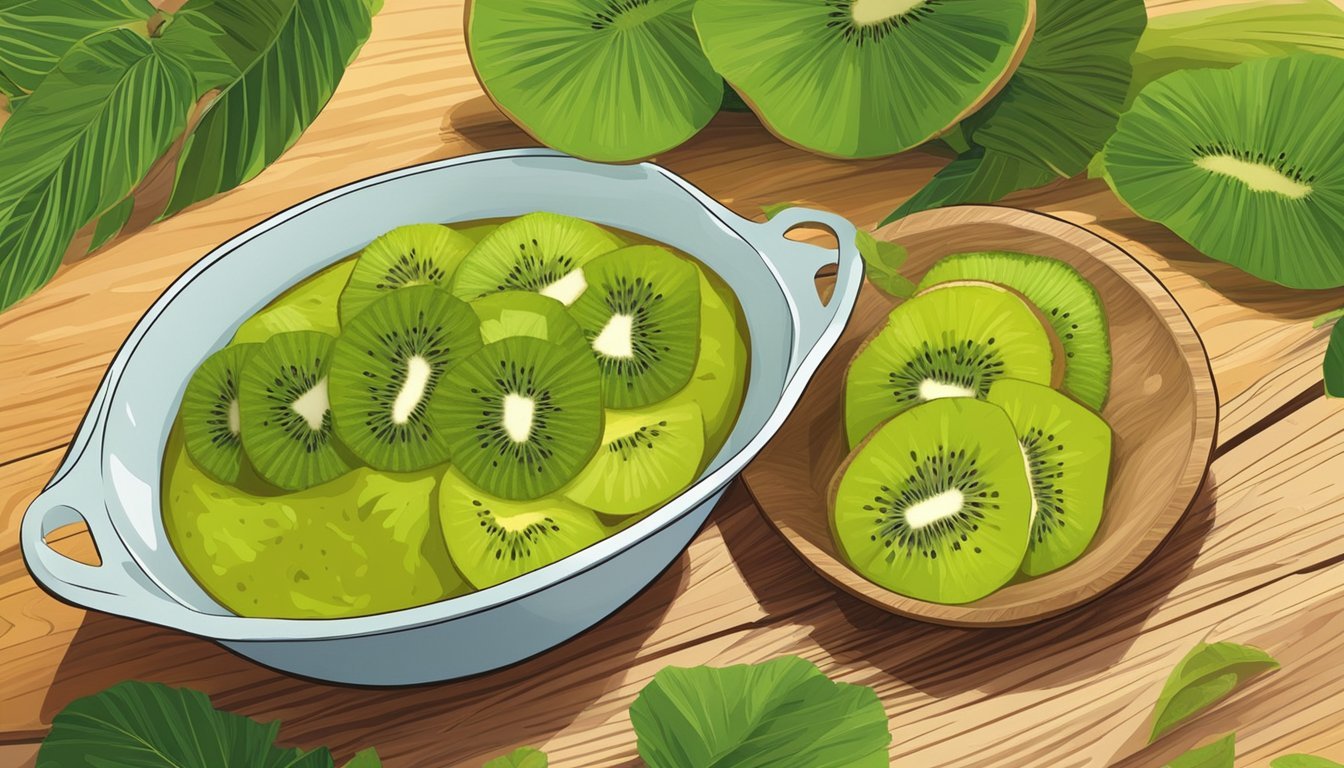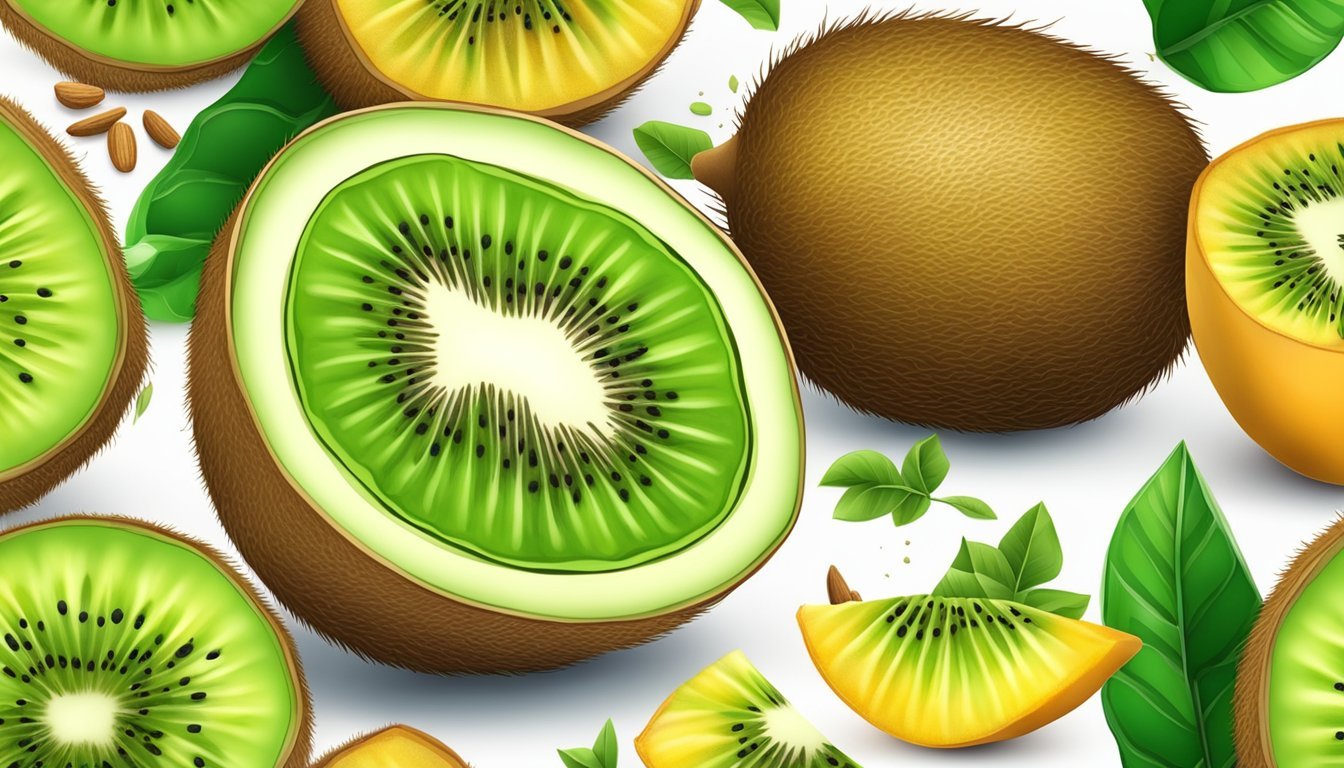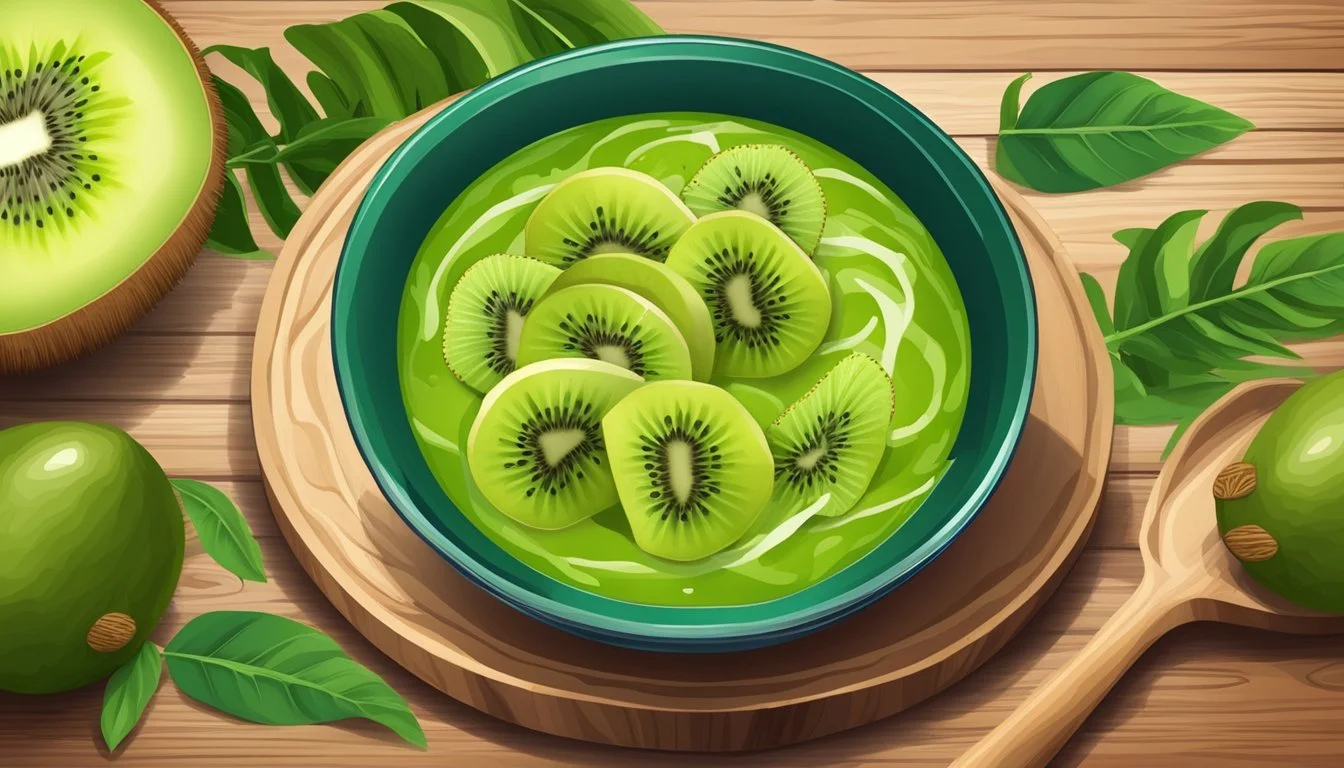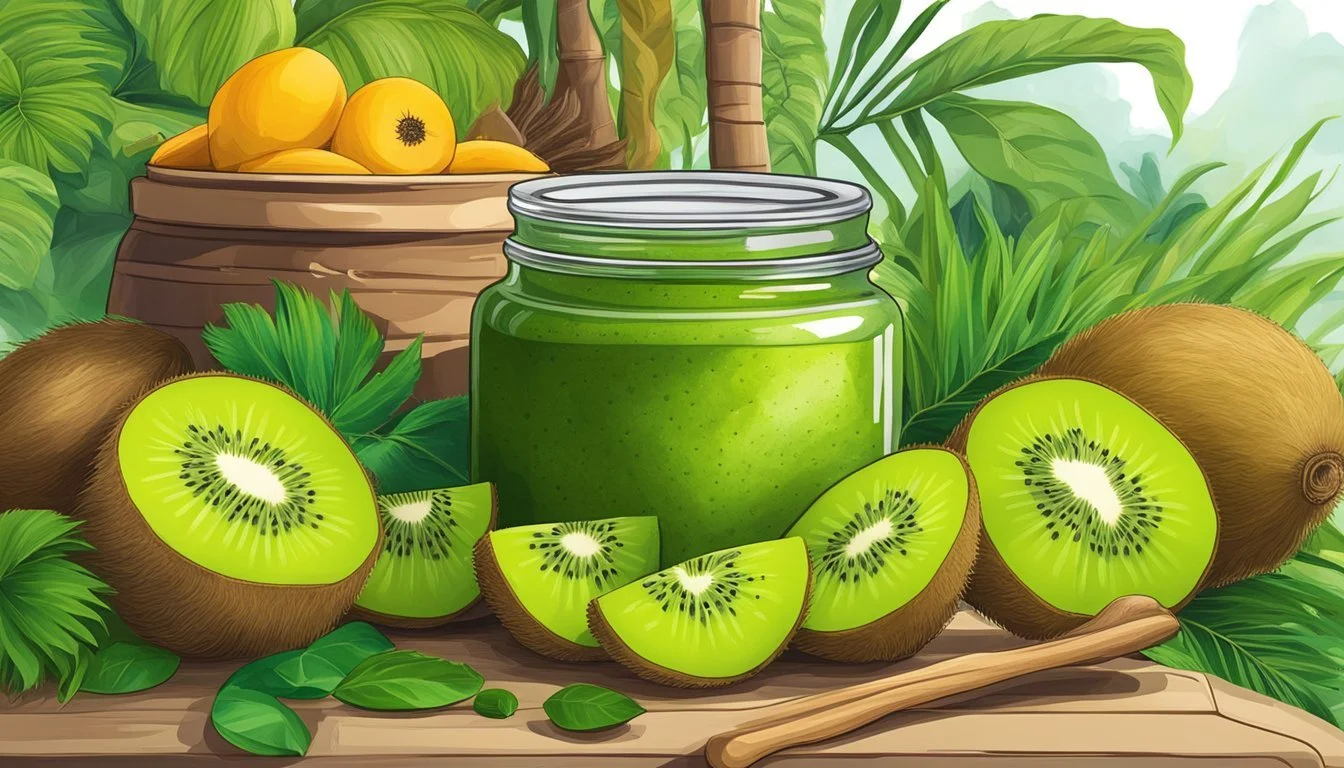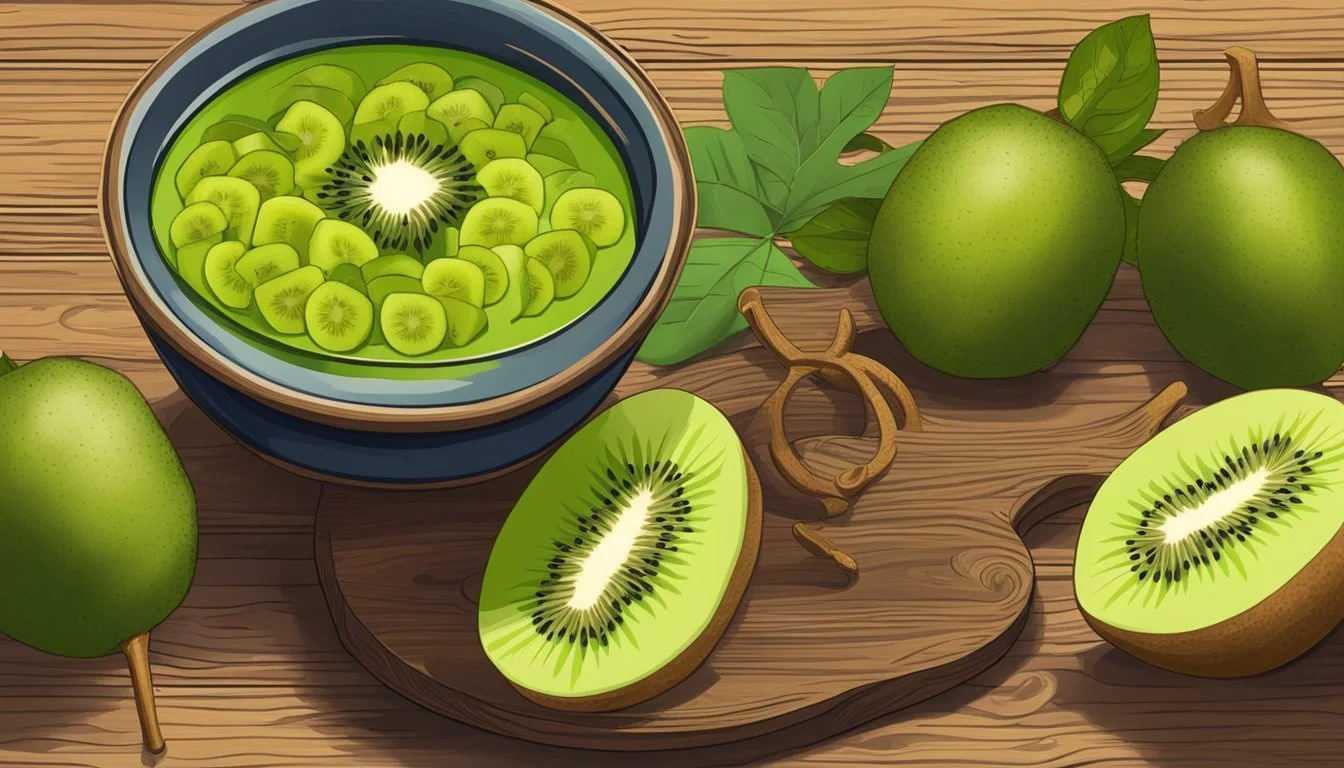Kiwi Peel Chutney
Unlocking the Flavors of a Tropical Delight
Kiwi Peel Chutney is an inventive and sustainable approach to creating a tangy, tropical condiment. Often discarded, kiwi peels contain valuable fiber and nutrients, making them an ideal ingredient for a resourceful chef. This type of chutney embodies the essence of culinary creativity, turning what is typically considered waste into a delightful blend of flavors. It combines the zesty taste of kiwi with traditional chutney spices, resulting in a versatile topping that can enhance numerous dishes.
By utilizing the entire kiwi, including the peel, this chutney not only promotes a no-waste philosophy but also introduces a novel texture and depth of flavor to the condiment. The preparation process marries the sweet-tartness of the kiwi peel with the savory elements of onions, garlic, and vinegar, often including an array of spices like ginger, cayenne pepper, and cardamom that provide a perfect balance of heat and sweetness. The result is a flavorful chutney that offers both environmental benefits and a fusion of tastes.
This chutney serves as an excellent accompaniment to a variety of meals. It can be savored with grilled meats, (What wine goes well with grilled meats?) used as a spread for sandwiches and wraps, or enjoyed as a unique dip. Its bright notes and spiciness make it particularly well-suited for summer gatherings, adding a tropical flair that can complement any table spread.
History and Origin of Kiwi Peel Chutney
Chutney is a versatile condiment that originated in India, known for its ability to elevate the taste of a dish by adding a unique blend of sweet, savory, and spicy flavors**.** Traditional Indian chutneys are made using a myriad of ingredients including fruits, herbs, spices, and vegetables.
The kiwifruit, while not native to India, has its own place in culinary history. Native to the temperate Yangtze Valley of China, kiwifruits were brought to New Zealand in the early 20th century. Here, innovative culinary practices led to the development of Kiwi Peel Chutney. Utilizing the often discarded peels of the kiwifruit, this chutney embraces the concept of sustainability while providing a tangy and tropical flavor to the palate.
The kiwi peel, rich in fibers and possessing a distinct tartness, complements the traditional chutney base. When transformed into chutney, the peel not only enriches the condiment with its vibrant green hue but also adds a textural contrast. The creation of Kiwi Peel Chutney can be seen as an adaptation of the classic Indian relish, combining the subcontinent's culinary practice with New Zealand's resourceful approach to its local produce.
In summary, Kiwi Peel Chutney is an example of cross-cultural culinary innovation that has extended the traditional Indian art of chutney-making, integrating the unique qualities of the kiwifruit peel into a beloved condiment.
Nutritional Value
Incorporating kiwi peel into chutney not only adds a unique tangy flavor but also offers a range of nutrients beneficial to health.
Vitamins and Minerals
Kiwi peel chutney is a rich source of Vitamin C, vital for immune system function and skin health. It also contributes essential minerals like potassium, requiring for maintaining normal blood pressure. Additionally, the peel contains folate (Vitamin B9), which is crucial for the production of red blood cells and converting carbohydrates into energy.
Vitamin C: Significantly present in kiwi, aids in wound healing and the maintenance of healthy skin.
Potassium: Helps regulate fluid balance and supports heart health.
Folate: The skin of the kiwifruit notably boosts folate intake, essential for energy production.
Caloric Content
While adding flavor to dishes, kiwi peel chutney does so with a low caloric contribution. A medium-sized kiwi without the peel typically contains about 42 calories. Including the peel increases the caloric value marginally, but it is still considered low in calories, making it a suitable addition to a calorically-conscious diet.
Calories: Low-calorie condiment option for enhancing food flavor.
Protein: Kiwifruit contains a nominal amount of protein.
Fiber: High in dietary fiber, contributing to improved digestion and satiety.
Cholesterol and Saturated Fat: Kiwifruit and its peel contain negligible amounts of cholesterol and saturated fat, making them heart-healthy options.
Selecting the Best Ingredients
When preparing Kiwi Peel Chutney, choosing high-quality ingredients is crucial. A chutney's flavor starts with its fresh components, especially the primary fruit involved. For the kiwifruit, one should pick specimens that are ripe yet firm, indicating they're at their peak in both sweetness and tanginess. A ripe kiwifruit should give slightly under gentle pressure.
Essential Ingredients:
Kiwi: Ripe, yet firm kiwifruits are ideal.
Vinegar: Opt for white vinegar for a clean, sharp taste.
Sugar: Use brown sugar to add a depth of flavor.
Salt: A pinch of salt balances the sweetness and enhances the overall flavor profile.
Quality Check Table:
Ingredient Quality Indicator Kiwi Ripe yet firm, gives slightly under pressure Vinegar Clear, with a sharp aroma Brown Sugar Free of clumps, rich in color Salt Pure, without added caking agents
The vinegar used in the chutney acts as a preservative and flavor enhancer. One should ensure that it is of good quality, without any cloudiness or off-smells that could indicate spoilage.
The role of sugar isn't just to sweeten but also to balance the acidity of the vinegar. Brown sugar is preferred for its caramelly undertones. It should be lump-free and have a rich molasses aroma.
Lastly, even a small amount of salt makes a significant difference. High-quality salt, free of added agents, will ensure the chutney attains a well-rounded taste.
Preparing the Kiwi Peel
The kiwi peel, often discarded, is a hidden gem for creating a robust chutney with a tangy tropical flavor. The preparation begins with selecting ripe kiwis to ensure a good balance between sweetness and tartness. It is essential that the kiwis are thoroughly washed to remove any dirt or residues since the peel will be used in the chutney.
Step 1: Slice off both the top and the bottom of the kiwi to create a flat surface on each end. This makes it easier to handle and peel.
Step 2: Using a spoon or a peeler, carefully remove the peel. The spoon method is particularly effective:
Hold the kiwi in one hand.
Place a spoon between the flesh and the peel.
Rotate the kiwi, allowing the spoon to separate the peel intact.
Tool Method Spoon Gently separate the peel Vegetable Peeler Peel the sides of the kiwi
Step 3: Slice the peel into thin strips. These strips will provide texture and a vibrant green hue to the chutney.
Incorporating fresh ginger enhances the chutney with a zesty note. Peel the ginger root and grate it finely, using approximately one tablespoon for a zing that complements the kiwi's tanginess.
To extract the full flavor from the kiwi peel and ginger, simmer them in a minimal amount of water. This method allows the aromatics to soften and the flavors to marry, forming a base for the chutney's complex profile. The peels should be cooked until they become tender and easy to blend into the chutney mix.
Chutney Flavor Profiling
Chutney is a condiment that masterfully combines a variety of flavors and ingredients to create a unique taste experience. The flavor profile of Kiwi Peel Chutney specifically, builds on the interplay between spices, sweetness, and heat.
Spices and Seasonings
Chutneys often incorporate an array of spices and seasonings to achieve their characteristic depth of flavor. For Kiwi Peel Chutney, cardamom and cinnamon add warm notes, while ground coriander brings a hint of citrusy, floral undertones.
Ginger: Provides a sharp, peppery taste with delicate lemon undertones.
Cumin: Offers a nutty, warm essence that enhances the chutney’s complexity.
These spices are carefully measured to ensure they complement the kiwi’s natural tanginess without overpowering it.
Sweet and Savory Balance
The sweet and savory elements in chutney must be balanced. Brown sugar or sugar is used for sweetness, which contrasts with the natural acidity of the kiwi. The savory aspect is often introduced by incorporating caramelized onions, which add a rich, umami flavor, and salt, which sharpens the overall profile.
Sweet: Typically achieved with sugar; brown sugar can add a molasses note.
Savory: Onion and salt are key for the savory backbone of the chutney.
Adjusting Spiciness
The level of spiciness in Kiwi Peel Chutney can be adjusted to fit different palates. Red pepper flakes can be added for those who appreciate a fiery kick. If one prefers a more mild chutney, they may either reduce the amount of red pepper flakes or omit them altogether.
Mild: Minimal or no red pepper flakes.
Hot: A generous pinch of red pepper flakes to turn up the heat.
By managing the quantity of these spicy elements, the chutney maker can cater to a range of spice preferences.
Cooking Technique
To create a delightful Kiwi Peel Chutney, one must navigate the simmering process with precision to achieve the ideal consistency and texture that makes this condiment a tropical treat.
Simmering Process
The simmering process is fundamental in chutney making. It begins by combining kiwi peels, vinegar, sugar, and a mix of desired spices in a saucepan. The mixture should reach a boil, after which the heat is reduced to let it simmer gently. This slow cooking method allows the flavors to meld beautifully and the kiwi peels to soften adequately. Attentively monitoring the simmer is critical, as it prevents the ingredients from burning and helps to infuse the flavors.
Consistency and Texture
Achieving the perfect consistency and texture in Kiwi Peel Chutney involves reducing the mixture during the simmering process. The goal is to evaporate enough liquid so the chutney thickens, but not so much that it becomes overly dense or dry. A spoon test can be an effective way to gauge the chutney's readiness—dip a clean spoon into the mixture, and if the chutney coats the back of the spoon without dripping off quickly, it has reached the desired consistency. The texture should be smooth with small chunks of kiwi peel present to add a slight bite amidst the tanginess of the chutney.
Complementary Pairings
Kiwi Peel Chutney enhances a variety of dishes with its tangy and sweet flavor profile. Its versatility makes it an ideal condiment for numerous culinary pairings, particularly for those looking to add a tropical twist to their meals.
Meat and Poultry
For meat enthusiasts, Kiwi Peel Chutney pairs beautifully with pork, especially when glazed over roasted or grilled cuts. The chutney's acidity complements the richness of the pork, creating a balanced flavor. Chicken, whether grilled or baked, can also benefit from the chutney's zesty character, giving the poultry a refreshing lift.
Seafood and Vegetables
Seafood lovers will find that Kiwi Peel Chutney goes well with white fish and shrimp, offering a welcome contrast to the delicate flavors of these foods. The chutney can be used as a marinade or a finishing touch for a sophisticated palate. As for vegetables, the chutney can serve as a dressing to brighten up salads or roasted veggies.
Cheese and Appetizers
When it comes to cheese and appetizers, Kiwi Peel Chutney becomes a delightful addition to cheese platters, pairing especially well with soft cheeses that can benefit from a hint of tanginess. It can also be a star ingredient in an appetizer, providing a unique taste component to small bites such as crostini or bruschetta.
Serving and Presentation
Kiwi Peel Chutney adds a unique, tangy twist to meals and snacks with its vibrant flavor profile. Presentation is key; the chutney serves as an enhancer to a wide array of dishes, both as a stand-alone condiment and an ingredient within recipes.
As a Condiment
Kiwi Peel Chutney shines when presented as a condiment to complement a variety of dishes. It can be:
Served alongside: It acts as an excellent side to grilled meats, providing a punch of tropical acidity that cuts through the richness.
Utilized as a spread: A thin layer on sandwiches or burgers adds a zesty, fruity dimension.
Offered as a dip: It pairs well with cheese platters or as a dipping sauce for finger foods, especially when seeking a balance of sweet and sour flavors.
In Recipes
Incorporating Kiwi Peel Chutney into recipes is a creative way to elevate everyday cooking. Consider the following:
Stirred into: It can be swirled into yogurt or oatmeal for a breakfast with a kick.
Mixed with: Enhance salad dressings or marinades by mixing in the chutney for added complexity.
The tropical notes of the chutney are particularly complementary when used with seafood or poultry, infusing these dishes with a sweet and tangy essence.
Preservation and Storage
Preserving Kiwi Peel Chutney ensures that its tangy and tropical flavors are maintained over time. Proper storage techniques are critical to prevent spoilage and to extend the shelf life of the chutney.
Temperature Control: Always store Kiwi Peel Chutney in a cool and dry place within the refrigerator. The optimal temperature range for refrigeration is between 40°F (4°C) and 50°F (10°C). This temperature range slows down the spoilage process by hindering the growth of bacteria and mold.
Airtight Containers: To ensure the chutney maintains its quality, it is essential to use an airtight container. This not only helps to keep out contaminants but also seals in freshness and prevents the chutney from absorbing other flavors and odors present in the refrigerator.
Steps for Refrigeration:
Transfer the chutney into a clean, airtight container.
Secure the lid to create an airtight seal.
Label the container with the date of storage.
Place in the fridge.
Direct Light Avoidance: Chutney should be stored away from direct light exposure, especially sunlight. Light can degrade the quality of the chutney and lead to discoloration.
Expiry Date: Monitor the chutney regularly to ensure that it is consumed before its expiry date. Generally, homemade chutney can be safely kept in the refrigerator for up to two weeks, provided it has been refrigerated promptly after cooking and stored correctly.
By adhering to these storage principles, Kiwi Peel Chutney can be enjoyed at its best quality over time.
Recipe Variations
Kiwi Peel Chutney offers a canvas for a creative assortment of flavors. Through fruit and spice variations, one can tailor the condiment to pair exquisitely with various dishes or accommodate personal preferences.
Fruit Variations
One can easily adapt Kiwi Peel Chutney by incorporating different fruits. Adding mango enhances the chutney’s tropical essence and natural sweetness. Introducing fresh pineapple or canned pineapple can impart a tangy flair, while mixing in raisins or apples can provide a delicate, contrasting texture. A balance with lemon juice can help preserve the freshness of the fruits and add a zesty note.
Mango: Adds sweetness and a rich, tropical flavor.
Pineapple (Fresh/Canned): Brings a tangy vibrancy and juiciness.
Raisins: Introduce a chewy texture and natural sweetness.
Apples: Provide a subtle tartness and firmer bite.
Lemon Juice: Acts as a preservative and enhances the chutney's tanginess.
Spice Variations
The chutney’s essence can be transformed with different spices. Ground ginger infuses a warm, spicy kick. Cumin, cardamom, and cinnamon are aromatic spices that layer the flavor profile with complexity. For the vinegar component, one can choose apple cider vinegar for its fruity notes, white wine vinegar for a milder tang, or white vinegar for a sharper acidity. Adjusting the sweetness with light brown sugar can complement the chosen spices, creating a well-rounded condiment.
Ground Ginger: Lends a warm and spicy note.
Cumin: Offers a nutty and earthy flavor.
Cardamom: Delivers a sweet and aromatic touch.
Cinnamon: Contributes a woody and sweet richness.
Vinegars (Apple Cider/White Wine/White): Each adds a distinct level of tanginess and flavor.
Light Brown Sugar: Provides sweetness with a hint of molasses flavor.
Health Considerations
When one considers incorporating Kiwi Peel Chutney into their diet, it is important to note its nutritional value. Kiwi peels are notably rich in fiber, which aids in digestion and promotes a feeling of fullness, potentially aiding in weight management. Furthermore, the vitamin C content is substantial. This antioxidant plays a crucial role in immune function and skin health.
On the subject of fat and saturated fat, Kiwi Peel Chutney is naturally low in these components, making it a heart-friendly condiment option. It contains no cholesterol, which further supports cardiovascular health.
Here is a brief nutritional breakdown focused on the mentioned entities:
Nutrient Benefit Dietary Fiber Supports digestive health Vitamin C Antioxidant; boosts immune system Low in Fat Heart-friendly Low in Saturated Fat Reduces risk of heart disease Cholesterol-Free Promotes cardiovascular health
In terms of calories, Kiwi Peel Chutney is a low-calorie option that adds flavor without significantly increasing daily caloric intake. The addition of kiwi peel in recipes not only enriches flavor profiles but also offers a nutritious alternative to traditional condiments that may be higher in calories and less nutrient-dense.
It's also pertinent to mention that those with allergies should be cautious as kiwi is a known allergen. It's always recommended to try a small amount first if you have not consumed kiwi peel before.
Culinary Context
Kiwi Peel Chutney offers an inventive twist to traditional chutneys, merging the zesty flavor of kiwi with the time-honored technique of chutney-making. This unique condiment bridges various culinary practices with its global appeal and versatile use.
Cultural Significance
In India, chutneys hold an esteemed place, traditionally made with a variety of fruits, herbs, and spices. They are an essential accompaniment to meals, serving as a palatal cleanser and flavor enhancer. While not a traditional Indian condiment, Kiwi Peel Chutney incorporates the Indian method of chutney preparation that often employs a balance of sweet, spicy, and tangy components.
Modern Usage
Today, Kiwi Peel Chutney adapts to contemporary palates, finding its place not only in Indian cuisine but across various culinary spectrums. Here's how this chutney complements different dishes:
Main Course: It pairs well with curries, lending a refreshing contrast to the rich flavors.
Salads: The chutney can be used as a dressing base, adding a tropical twist to green salads.
Cheese and Crackers: Its tangy taste complements the creaminess of cheese, perfect as a spread on crackers.
Grilled Meats: It serves as an excellent condiment for grilled meats, providing a fruity balance.
Desserts: A spoonful can top off a dessert, adding complexity to the sweetness.
Jam Alternative: It's an innovative substitute for jam on toast or scones.
Notably, the chutney is renowned for being easy to make, broadening its reach in home kitchens and professional settings alike.
Final Thoughts
Kiwi peel chutney stands out as a homemade creation that adds a unique twist to the array of condiments one might typically encounter. Its preparation allows home chefs to approach cooking with confidence, embracing the concept that waste can be transformed into something delectable.
Incorporating kiwi peels — often discarded — home cooks champion sustainability. They create a chutney that not only reduces food waste but also imparts a tangy, tropical flavor profile to various dishes. The very act of creating this chutney from scratch reinforces the versatility of familiar fruits.
This chutney pairs well with a spectrum of foods:
Cheeses: A surprising complement to both soft and hard cheeses
Grilled Meats: Enhances flavors with its distinctive tang
Curries: Adds complexity to both vegetarian and non-vegetarian options
Finally, they find that kiwi peel chutney can be easily adjusted to personal taste. A bit more sugar for sweetness, an extra dash of spice for heat, or perhaps more vinegar for acidity — the adaptations are endless. This not only provides an avenue for culinary creativity but also reassures those in the kitchen of its versatility. Whether one's kitchen skills are novice or expert, creating a batch of kiwi peel chutney can be a rewarding and delicious experience.

